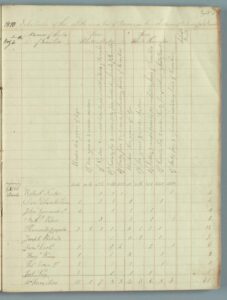 Over the years I have fielded a number of questions about why researchers haven’t been able to locate their ancestors in the 1810 census for Salem, Massachusetts, when other records place these ancestors there for their entire lives.
Over the years I have fielded a number of questions about why researchers haven’t been able to locate their ancestors in the 1810 census for Salem, Massachusetts, when other records place these ancestors there for their entire lives.
Well, the simple answer was that in the census for 1810, as made available through the National Archives and Records Administration on microfilm (which is where all the digitized census records on sites like Ancestry.com and FamilySearch.org have come from), somehow the town of Salem was not included.
As I was manning our Monday-through-Saturday Ask a Genealogist Chat recently, this question once again popped up. This time the researcher was living in England and trying to identify a “Mr. Burbank” who in 1809 was living on Sixth Street in Salem. He had previously been unable to find any records of this man. I had just shared the bad news about the Salem 1810 census when a colleague, Melanie McComb, let me know that Peabody Essex Museum had recently found the 1810 census and it was now digitized online. I shared this information with the gentleman, who thanked me and went off to check it out.
I, of course, immediately clicked the link my colleague shared with me. Before turning the register over to the National Archives and Records Administration on 16 April 2021, it was scanned and made available on Archive.org, home to many digitized books which have aided so many genealogists in the past year of COVID-19 home quarantine. You can find the register here: Salem Mass., census, 1810.
I, of course, immediately clicked the link my colleague shared with me.
Unlike the digitized microfilm census pages, this is the original ledger book of the 1810 census. It was recorded in Salem by Ebenezer Burrell, who was assisting the U.S. Marshal for Massachusetts in compiling the census, and he certified that it was completed by him on 1 October 1810. Yes, it is still the head of household tally with the others identified by age, gender, and race, but having the original ledger book to view is an amazing find. While it can’t be said that all the enumerators used the same ledger, with greenish pages that resemble those used by finance people with red lines to divide the columns for age, gender and race, it does appear to be similar to others of the period.
Quite frankly, I absolutely love the digitized records that are coming from original pages rather than microfilm. With the original pages, and the colors of inks, it is much easier to tell just what is going on with a particular document. The colors remind us of all of the historical documents we use on a daily basis, but for me, at least, the colors bring to mind a clearer view of that history.
What is most astounding about this discovery is that it was only recently uncovered – the result of creating a social media item for the Peabody Essex Museum’s Phillips Library Instagram account (https://www.instagram.com/pemlibrary/) back on 17 February 2021. The register was part of a selection of un-catalogued records in PEM’s possession. However, it wasn’t until the National Archives reached out that PEM realized that their register was apparently the only surviving copy of the 1810 census for the town of Salem, and that is when it was transferred.
All of us who have residents in Salem in 1810 among our ancestors can now use the Archive.org digital pages to locate them. It does require going through the images page by page, as there is presently no searchable index of the handwritten pages. Some may be put off by this, but I’ll be diving in and enjoying another recovered, valuable resource.
*
Editor's note: Since this post was first published, American Ancestors has made an important new, searchable database available: Salem, MA: United States 1810 Census, the result of a partnership between the Phillips Library at the Peabody Essex Museum (PEM) and American Ancestors/NEHGS after the 2021 discovery that the Phillips Library had the only surviving copy of the 1810 Federal Census for Salem, Massachusetts.
Now that there is a searchable database of the original, approximately 100 handwritten pages, researchers don’t have to read each page in its entirety to locate a name. Anyone researching ancestors who lived in Salem in 1810 can use it to locate the tallied families. The database contains the full pages of the 1810 Federal Census for Salem with more than 2,200 records and searchable names (by first and last name) and is available to all American Ancestors members, including free Guest Members.
Share this:
About Rhonda McClure
Rhonda R. McClure, Genealogist, is a nationally recognized professional genealogist and lecturer specializing in New England and celebrity research as well as computerized genealogy; is compiler of more than 120 celebrity family trees; has been a contributing editor for Heritage Quest Magazine, Biography magazine and was a contributor to The History Channel Magazine and American History Magazine. In addition to numerous articles, she is the author of ten books, including the award-winning The Complete Idiot's Guide to Online Genealogy, now in its second edition, Finding Your Famous and Infamous Ancestors, and Digitizing Your Family History.View all posts by Rhonda McClure →